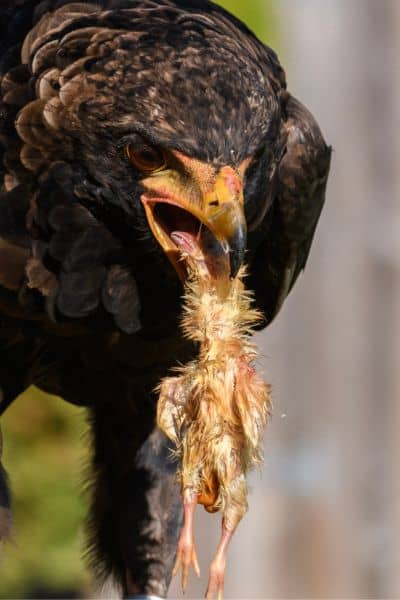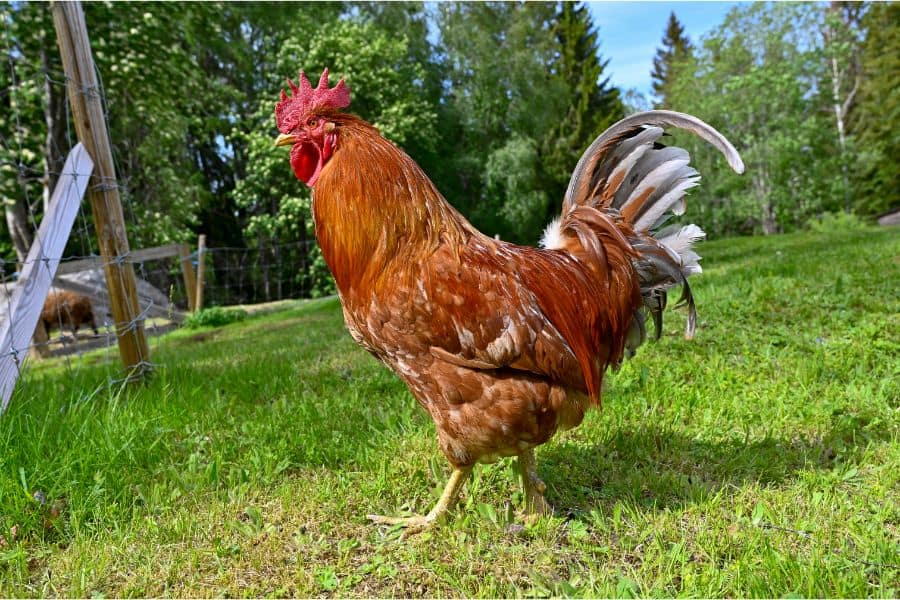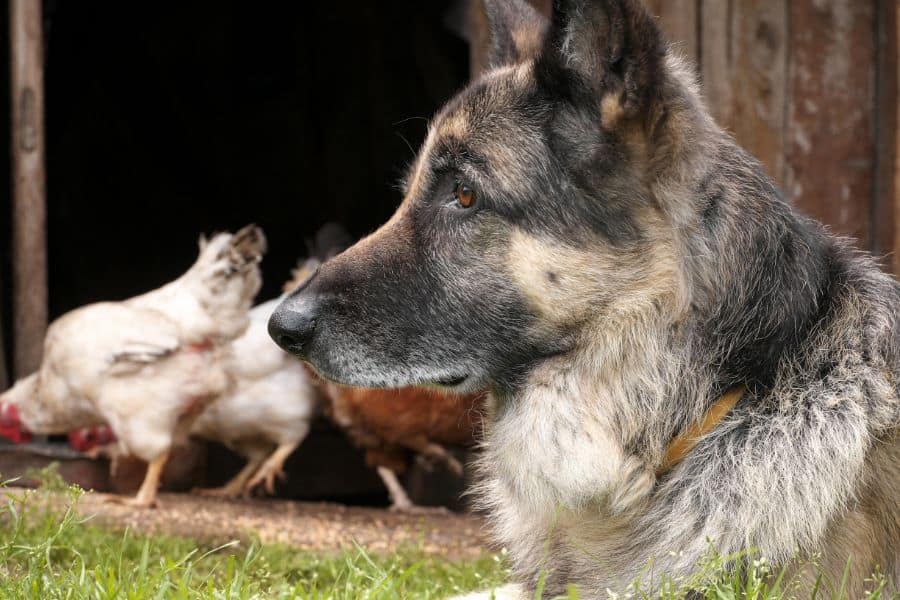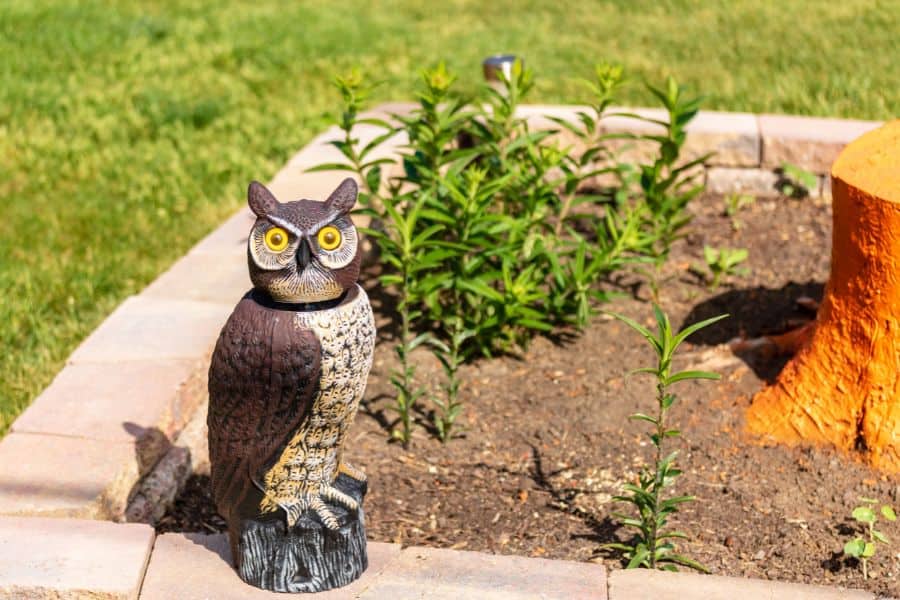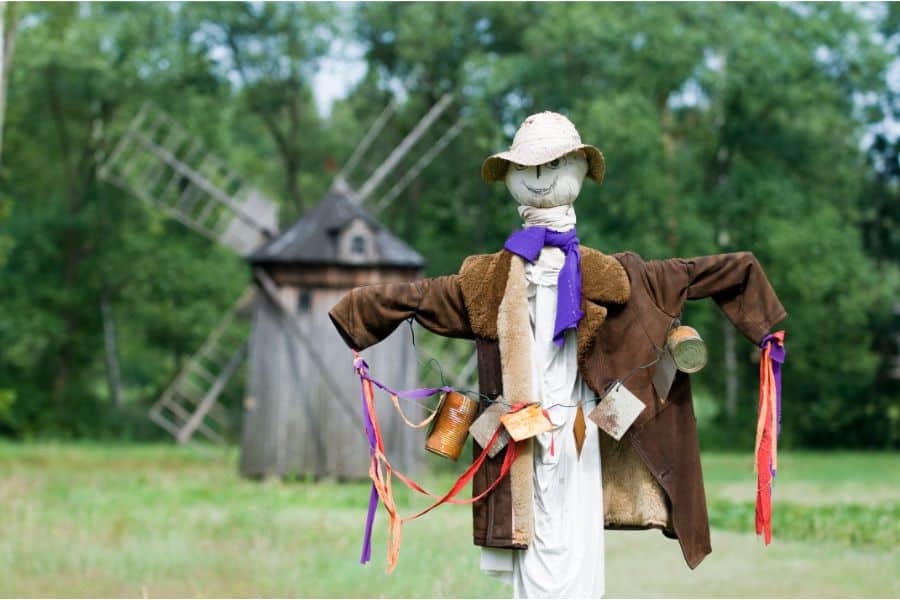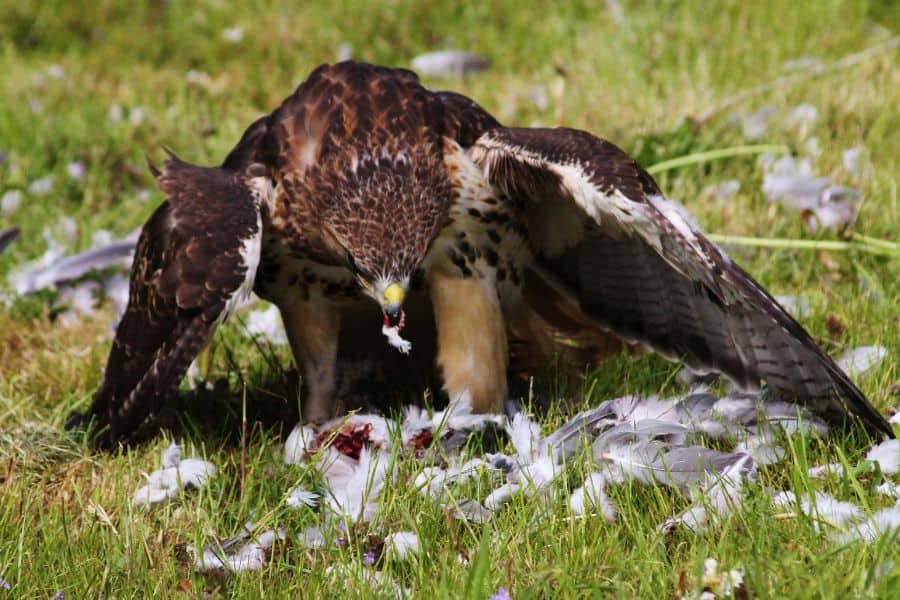Are hawks constantly hunting and killing your chicken? Or are you interested in effective ways to deter these birds from your home?
Hawks, like other birds of prey, can hamper your poultry production efforts significantly. Not only do they prey on chicks, but can also transmit diseases to poultry and humans.
Even worse, they can force you to erect fences and construct predator-proof coops, which increases the cost of production.
But don’t fret! There’s a solution to your problem.
In this guide, we will highlight several tips and tricks to help you keep these pesky invaders away from your property.
So, stick around and learn how to keep your feather friends safe, healthy, and happy.
7 Tips To Protect Your Chicken from Hawks
1. Add A Rooster to Your Flock
Sure, roosters help fertilize chicken eggs. But did you know they have exceptional protective instincts? In fact, they will do everything possible to keep your hens and chicks safe.
Roosters are always on the lookout for any sign of danger. And when they spot a potential predator, the roosters will sound the alarm to alert the entire flock of the looming threat.
A rooster will also herd chickens to safety. He will walk back and forth, keeping the crew together until the danger passes.
So, if you’re tired of hawks stealing your chickens, it’s time to introduce a strong and sturdy rooster that can protect the ladies and the babies.
2. Employ A Guard Animal
A guard animal is an animal specifically trained to protect your flocks. These animals often intermingle with chickens and will sound an alarm when a predator is around. Sometimes, guard animals can fight off attackers to keep your chickens safe.
Dogs are arguably the most popular guard animals. Dog breeds like the Anatolia Shepherd, Great Pyrenees, and Old English Sheep Dog excel at protecting your property as well as its inhabitants.
These guard dogs will disrupt the attack attempts of hawks and alert the flock to potential threats. Oftentimes, the dogs will confront the predator directly, whether it’s a hawk, fox, or weasel.
But remember dogs are super playful, and without the proper training, they may hurt or kill your chickens while playing. Also, some breeds are difficult to train and might see your two-legged, feathery friends as food.
Luckily, you have other guard animal options. These could include:
- Alpacas
- Llamas
- Donkeys
- Guinea fowls
- Geese
3. Coop Your Chickens
It’s no secret that free-ranging offers chicken farmers several advantages like reduced feed cost, richer eggs, and healthier meat. However, it’s not without its downsides. For instance, free-range chickens are prone to attacks from hawks and other predators.
If you’re going to leave your chicken unattended without any hawk deterrent measures in place, consider keeping them in a coop.
A chicken tractor is a great way to go, especially if you have a small flock. It is a portable coop that allows your chicken to forage on fresh grounds while keeping them safe.
Building a chicken “Tunnel” or “Chunnel” is another viable option. Made from chicken wire and PVC piping or boards, a chicken tunnel keeps your birds safe while allowing them to roam freely in your backyard.
And the best part? Chicken tunnels are good for your garden too. If wrapped around the perimeter of your garden beds or crops, it will encourage your chickens to eat weeds and insects that cause havoc on your plants.
4. Cover Your Chicken Run
It is vital to cover your chicken run if you want to keep your birds safe. Besides its obvious benefit – shelter from rain and sun, a chicken run cover makes a good hawk a deterrent.
A chicken run cover makes it hard for predatory birds to swoop in from above and take a baby chick or young hen.
In addition, these covers create a barrier from falling debris. This is crucial for preventing the spread of avian flu to your flock. Usually, this virus is transmitted via droppings of birds that fly over your chickens.
5. Relocate Your Feeders and Watering Stations
Many species of hawks, such as the Cooper’s hawk, and the sharp-skinned hawk, usually target feeding and watering stations. This is because chickens are most vulnerable when they’re eating.
Chickens usually lower their heads when they eat or drink. This forces them to let their guard down and become less informed about their surroundings. They also bunch together when eating, which makes them easy pickings for hawks hovering above.
The chicken feeders might also attract other wild birds that hawks feed on. So, if you notice a hawk hanging around your feeders or watering station, it’s time to remove or relocate them to a safer location until the hawk moves on.
6. Add Black Chicken to Your Flock
Believe it or not, adding a black chicken to your flock is one of the simplest methods of keeping hawks away. We know this sounds more like a myth, but it’s a fact.
So, what makes these chicken-effective hawk deterrents? Well, the secret lies in their coloration. Hawks often confuse black chickens with crows, who are also black.
Hawks detest crows and ravens since these birds have made it their hobby to torment and chase hawks. So, a hawk might mistake your black chicken for a crow and keep its distance to avoid becoming a target of their pestering.
7. Increase Visibility
This method could work for you or against you. Hawks usually perch in nearby trees to stalk their prey. If you live in an area with tall grass and bushes, it might prove difficult to detect these birds.
So, cut down any overgrown bushes and grass in your surroundings. By doing so, you can reduce potential covers for the hawks and increase your chances of spotting this predator before it attacks.
On the downside, those bushes might help protect your chickens. Chickens can hide under bushes when they spot a hawk. This reduces the chances of getting picked up by the aerial hunter.
In such a case, experts recommend only cutting down overgrown bushes that could hide a lurking hawk.
6 Ways to Scare Hawks Away
1. Install Guard Owls/ Decoy Owls
Hawks consider owls as a threat because they are large than them and have powerful talons and beaks. And sometimes, they end up on the Owls’ dinner plate. This holds, especially for the Snowy owl and Great-horned owl.
Therefore, investing in a few fake owls or decoys can help keep your flock safe. Once you have purchased the decoy, mount it near your chicken coop.
But remember to move the decoy around frequently for the best results. Hawks are intelligent predators. And if they don’t observe any movement from the fake owl, they might swoop in for the hunt.
2. Use Noise Deterrents
Certain sounds at specific frequencies can help keep hawks away. However, for this method to be effective, the sound must be turbulent, loud, and annoying to predators, but not to chickens, people, or pets.
An ultrasonic bird repellent features multiple customizable frequencies, sensitivity, and volume settings. It also comes with blinking lights, a great feature to keep hawks at bay even at night.
Sound or noise deterrents are highly effective, humane, and environmentally conscious. There’s little to no chance of injuring the hawks.
3. Hang Up Shiny Objects
The Hawks are not the biggest fans of bright lights. Any shiny object that reflects sunlight into the sky will startle the bird and foil any attempts at hunting your flock.
For this method to work, hang aluminum pie plates, strips of aluminum foil, or old CDs and DVDs around the yard or along the fence.
Point to note: Avoid putting up CDs or mirrors as they may potentially harm your chicken instead of keeping them safe.
4. Put Up a Scarecrow
Instead of using a decoy owl, you can use a scarecrow, particularly if you practice free-range chicken raring.
Scarecrows give the illusion of a human presence among the flock. As a result, it keeps away aerial and land predators that fear humans.
Like with decoys, change the scarecrow location as often as possible so that the hawk doesn’t catch the drift.
5. Add Wild Birdhouses Around Your Coop
This method is more of an alarm system rather than a protective measure. Birdhouses will attract smaller birds around your chicken pen.
Since these birds are small and often hunted by larger birds of prey, they’ve become much more observant than their chicken counterparts.
These birds usually notice hawks faster and make noises to alert other birds. The noises will also alert your chickens to watch out for hawks and stay close to cover.
On the other hand, if crows have nested around your pen, they can make a great hawk deterrent. Crows and ravens aren’t very fond of hawks and usually make their lives difficult by chasing them away from areas they’ve nested.
6. Run a Fishing Line or Deer Netting Over the Range
Using deer netting is very economical and effective. Especially for chicks and smaller chickens that are more vulnerable to hawk attacks. The deer netting acts as a visual deterrent, and hawks tend to avoid areas with this netting.
As for the fishing line, you can run it across your chicken run in a diamond pattern. Ensure there’s little space between the lines, but not more than 4ft. This way, you can prevent the hawk from flying through the spaces and getting to your chickens.
But keep in mind, the fishing line might deteriorate over time, so you regularly check the lines and replace damaged ones.
Additional Ways to Protect Your Flock from Hawks
1. Monitor The Coop
Hawks are not very fond of humans because we pose a threat to them. They often steer clear of human sight and avoid confrontations at all costs.
To keep hawk attacks on the minimal side, regularly supervise your chicken range. Hawks won’t approach the coop if they see a human close by.
2. Apply Multiple Deterrent Methods at The Same Time
Most hawk deterrent methods are highly effective on their own. But what if you spruce up the game by using multiple methods all at once?
For instance, you can use noise deterrents and decoys together. Or you can come up with a combo that effectively shields your chickens from predators.
3. Remove Hawk Vantage Points
Like eagles, hawks search for their prey on higher grounds before swopping in and snatching them. But to do so, they have to find convenient vantage points where they can observe their prey.
Therefore, if you eliminate spots hawks often perch on, you can keep these predatory birds away from your property.
First, identify their favorite perching spots, especially those within a 100-yard radius of your home. These could include individual tall trees, high fences, and nearby utility poles.
After that, remove these vantage points by cutting down free-standing trees or dead branches. For fences and utility posts, introduce anti-bird spikes.
4. Study Hawk Activity in Your Area
Last but not least, study the behavioral patterns of hawks that frequent your property. This way, you can figure out the best way to keep them away from your favorite birds.
Like many predators, hawks are tenacious hunters. They’re willing to risk it all, just to get to their prey. That’s why it’s so hard to keep them away.
Fortunately, these birds love easy prey. So, if your chicken lives in a well-secure coop and pen, they are safer than their free-range counterparts. The same goes for chickens that live in the woods (but your birds might still fall prey to other predators like owls, crows, and eagles).
By understanding a hawk’s behavior, you can employ the right deterrents or protective measures.
Also Read:
Final Thoughts
Despite their tendency to hunt and kill chickens, hawks are protected under the law. If you hunt, harass, possess, or harm any hawk or its cousins, the owl, eagle, and falcon, you might find yourself in jail.
So, how do you deal with this nuisance? It’s simple! Employ effective preventive measures to keep away the birds and protect your chickens. For instance, you can get a guard animal, be it a dog, llama, goose, or rooster. You can also install noise deterrents, scarecrows, and decoys.
But for the best result, we recommend you combine two or more methods mentioned above. This way, you can create a hawk-free environment, and your birds can live happily.
